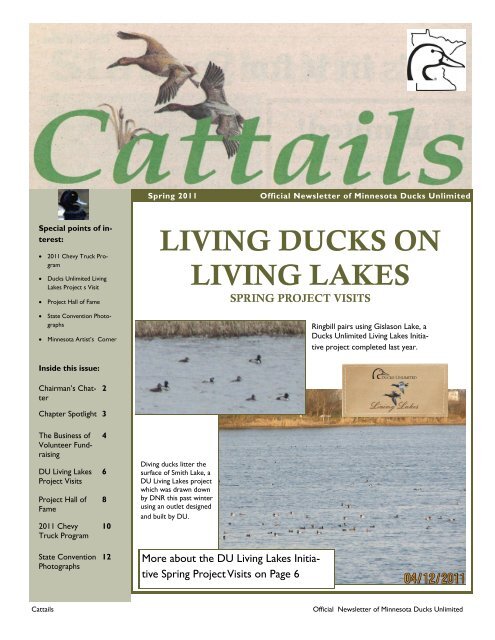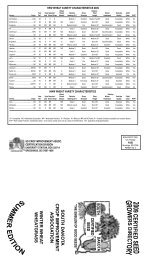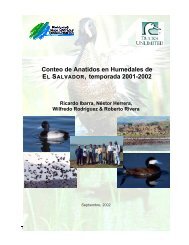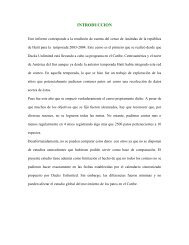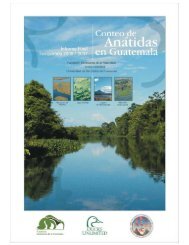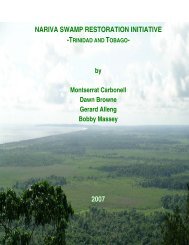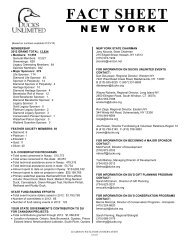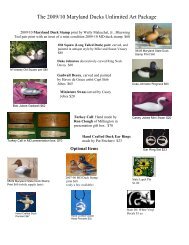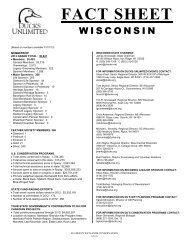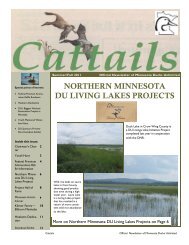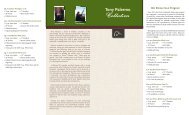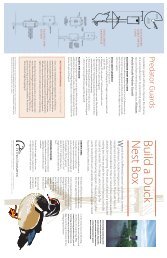LIVING DUCKS ON LIVING LAKES - Ducks Unlimited
LIVING DUCKS ON LIVING LAKES - Ducks Unlimited
LIVING DUCKS ON LIVING LAKES - Ducks Unlimited
Create successful ePaper yourself
Turn your PDF publications into a flip-book with our unique Google optimized e-Paper software.
Special points of interest:<br />
• 2011 Chevy Truck Program<br />
• <strong>Ducks</strong> <strong>Unlimited</strong> Living<br />
Lakes Project s Visit<br />
• Project Hall of Fame<br />
• State Convention Photographs<br />
• Minnesota Artist’s Corner<br />
Inside this issue:<br />
Chairman’s Chatter<br />
2<br />
Chapter Spotlight 3<br />
The Business of<br />
Volunteer Fundraising<br />
DU Living Lakes<br />
Project Visits<br />
Project Hall of<br />
Fame<br />
2011 Chevy<br />
Truck Program<br />
State Convention<br />
Photographs<br />
4<br />
6<br />
8<br />
10<br />
12<br />
Spring 2011<br />
<strong>LIVING</strong> <strong>DUCKS</strong> <strong>ON</strong><br />
Diving ducks litter the<br />
surface of Smith Lake, a<br />
DU Living Lakes project<br />
which was drawn down<br />
by DNR this past winter<br />
using an outlet designed<br />
and built by DU.<br />
<strong>LIVING</strong> <strong>LAKES</strong><br />
SPRING PROJECT VISITS<br />
More about the DU Living Lakes Initiative<br />
Spring Project Visits on Page 6<br />
Official Newsletter of Minnesota <strong>Ducks</strong> <strong>Unlimited</strong><br />
Ringbill pairs using Gislason Lake, a<br />
<strong>Ducks</strong> <strong>Unlimited</strong> Living Lakes Initiative<br />
project completed last year.<br />
Cattails Official Newsletter of Minnesota <strong>Ducks</strong> <strong>Unlimited</strong>
Page 2<br />
Dave Flink,<br />
State Chairman<br />
Your Minnesota DU<br />
State Committee<br />
State Chair<br />
Dave Flink<br />
Hutchinson, MN<br />
320-587-4246<br />
dflink@mnducksvolunteer.org<br />
State Council Chair<br />
Less Ness<br />
Chisago City, MN<br />
651-257-6413<br />
lness@mnducks.org<br />
State Chair Elect<br />
Tim Roble<br />
Frazee, MN<br />
218-334-4701<br />
dtroble@yahoo.com<br />
State Treasurer<br />
Dan Scheffler<br />
Northfield, MN<br />
507-291-0311<br />
danielscheffler1@gmail.com<br />
State Volunteer<br />
Recruitment Coord.<br />
Dale Lusti<br />
Buffalo, MN<br />
763-682-3468<br />
d.alelusti@aol.com<br />
State Convention Chairs<br />
Bob and Karen Sorenson<br />
Albert Lea, MN<br />
507-373-4931<br />
bnksorenson@hotmailcom<br />
State Major Gift Chair<br />
Russ Klint<br />
Benson, MN<br />
320-239-4322<br />
olcoot@metrolakes.com<br />
State Chairman’s Chatter<br />
Our spring banquet cycle is quickly coming to a close. To date, banquet results are positive<br />
in year to year comparison. Our positive financial results didn’t happen by accident.<br />
Your committees put extra effort into making adjustments. For example, your team might<br />
have lowered budget expenses, added an extra raffle or, in some cases, had a stick-to-it<br />
attitude and hosted an event. For your efforts, thank you.<br />
Local committees are the heart and soul of <strong>Ducks</strong> <strong>Unlimited</strong>. The events you coordinate<br />
play a critical role in recruiting new members and getting old members to recommit to<br />
DU. As you pause to reflect on the event just held or are starting to consider your fall<br />
banquet, think about how you can support the four “Rs”; recruit, retain, recommit and<br />
recognize your team.<br />
Our most successful chapters make recruitment a committee focus. They have come to<br />
realize that committee success is directly related to recruitment. If you’re interested in<br />
hosting a recruitment event, contact your zone chair or regional director to plan a recruitment<br />
event. Our senior volunteers and staff have the experience to make your efforts<br />
successful and rewarding.<br />
Lastly, thank you for what you do for the ducks.<br />
Hi Everyone,<br />
We recently completed a statewide planning session in Buffalo on Decem-<br />
Adam Hoekstra Dedication - May 7, 2011<br />
Cattails Official Newsletter of Minnesota <strong>Ducks</strong> <strong>Unlimited</strong>
Spring 2011<br />
Chapter Spotlight<br />
Winona State University Chapter<br />
The WSU Chapter is a rather new chapter, being only three years old, but they<br />
have been making great strides in organizing and fundraising. They have doubled<br />
their net/net from about $5,500 in their first year to almost $11,000 this year. Attendance<br />
at their event has more than doubled from 80 at their first event to 172<br />
at the 2011 event. The chapter now has 25 committee members and is striving to<br />
make next year’s DU Sweet 16 listing of top producing collegiate chapters by adding<br />
an outside raffle. These young DU committee members will also be great assets<br />
to their local committees in the future. As RD John Marks puts it, “They are<br />
rockstars and it keeps getting bigger and better”.<br />
Volunteer Spotlight<br />
Doug Cardwell got involved with DU many years ago because<br />
he wanted to fill the skies and make sure future hunters,<br />
such as his own kids, can enjoy waterfowl hunting like he<br />
has. He has served as a Greenwing chair, area chair and currently<br />
serves as a zone chair for southwest Minnesota. Doug<br />
helps our environment as much as he can by being involved in<br />
several different organizations working to help our environment.<br />
"I will tell you DU is one of the best organizations I<br />
have ever dealt with. If you have the passion like I do, join<br />
your local chapter today. It's a great feeling to fill the skies<br />
with ducks. Like the old saying goes, ‘fill the hall, fill the skies’.<br />
Plus, by joining DU, you meet new people all the time."<br />
Page 3<br />
Winona State<br />
University Logo<br />
Winona State University<br />
Chapter members<br />
with their Mallard<br />
Award at the 2011<br />
state convention. Attending<br />
are (front<br />
row , left) Pete Kuisle,<br />
Mike Carlson, Josh<br />
Morrissey, Hunter<br />
Brown (back row, left)<br />
Tyler Johannsen, Carrie<br />
Oswoski, Dan<br />
Silwa, Ben Gauger,<br />
Derek Hammen, and<br />
Tyler Smude.<br />
Doug and his son relax after working hard at a local<br />
event.<br />
Cattails Official Newsletter of Minnesota <strong>Ducks</strong> <strong>Unlimited</strong>
Page 4<br />
The Business of Volunteer Fundraising By Terry Kostinec, Regional Director<br />
Terry Kostinec,<br />
Regional Director for<br />
Central Minnesota<br />
“Team<br />
DU”<br />
Do you have an interest in waterfowling, conservation, being on a winning team<br />
and having fun?<br />
Then you need to become a part of a truly successful volunteer organization:<br />
<strong>Ducks</strong> <strong>Unlimited</strong>.<br />
For almost 70 years DU has used the talents and dedicated service of its volunteers<br />
to conserve more than 12 million wetland habitat acres in North America.<br />
Achievements like this do not happen by accident. It takes groups of volunteers<br />
at many levels to achieve this kind of impact on the landscape. Like everything<br />
else in this world, the DU mission requires money to make it happen. Raising<br />
money starts with people.<br />
People = Money = Habitat = <strong>Ducks</strong><br />
DU offers passionate outdoor enthusiasts an opportunity to become part of a<br />
volunteer fundraising team that is focused on a mission, dedicated to a cause<br />
and infuses a lot of fun into the process.<br />
DU starts at the local level with community chapters and hometown volunteers.<br />
These volunteers are the backbone of the organization. DU offers these volunteers<br />
the guidance, tools and information needed to plan and implement a successful<br />
fundraising event. Local people are able to give what they can of their<br />
time and talents. Some volunteers give a few hours, others can provide much<br />
more. The important point is DU offers a constructive approach with successful<br />
business methods to ensure all volunteers can help raise money to make a<br />
difference.<br />
Dave Flink educating volunteers at a Central Region district meeting.<br />
Cattails Official Newsletter of Minnesota <strong>Ducks</strong> <strong>Unlimited</strong>
Spring 2011<br />
The Business of Volunteer Fundraising (continued)<br />
At the state level, Minnesota has another group of dedicated volunteers. These volunteers<br />
came from the local ranks, but have stepped up to make a difference outside of<br />
their home town. With titles like zone, regional and state chairman, all state volunteers<br />
have past experience as chapter chairman on the local committee. They understand<br />
what it takes to raise money at the local level. They now have the opportunity to work<br />
with state fundraising programs that will positively impact the local events. Like most<br />
promotions in the business world, they must go through advanced training so that all<br />
state volunteers are working as a team delivering a consistent message with successful<br />
results. As a senior volunteer, they have the opportunity to assist local chapters by<br />
providing the most up-to-date information on successful volunteer recruitment techniques<br />
and fundraising methods. Senior volunteers conduct district meetings throughout<br />
the state each year to bring local chapters together<br />
to share ideas and learn about the most successful fundraising<br />
techniques. Senior volunteers provide the leadership<br />
and experience necessary to help ensure more of<br />
the money raised at the local events goes to funding the<br />
DU conservation machine.<br />
On the national level, a number of Minnesota volunteers<br />
are providing DU with their time and talents developing<br />
national grassroots fundraising goals and programs to<br />
meet the future demands of DU conservation initiatives.<br />
National DU volunteers come together a couple of times<br />
a year. They use these opportunities to discuss trends,<br />
learn about successful programs and develop a consistent<br />
message and pathways that volunteers in every state can<br />
follow to raise money and ensure the future of our waterfowl<br />
hunting heritage.<br />
Do you have what it takes to become<br />
part of this team?<br />
Contact the Minnesota DU State Office, 952-820-8174<br />
Northern MN DU Calendar Raffle<br />
Senior Volunteer Training<br />
The 2012 DU Calendar 104 Gun Raffle is underway. $40 per calendar<br />
• Tentative number of calendars...2,200...better odds to win than<br />
• Two guns per week for the whole year...same year...same great, price but twice the guns!<br />
YOUR C<strong>ON</strong>TACT INFO WILL BE GIVEN TO THE LOCAL VOLUNTEER CHAP-<br />
TER IN YOUR AREA AND YOU WILL BE C<strong>ON</strong>TACTED BY THEM TO RECEIVE<br />
YOUR CALENDAR. PLEASE BE SURE TO RESP<strong>ON</strong>D QUICKLY AT THAT<br />
TIME...CALENDARS CANNOT BE HELD FOR AN EXTENDED PERIOD OF TIME.<br />
Go to: www.duckscalendar.org to order yours.<br />
DU volunteers<br />
take their<br />
business<br />
seriously!<br />
Page 5<br />
2012 Minnesota <strong>Ducks</strong><br />
<strong>Unlimited</strong> Calendar<br />
Cattails Official Newsletter of Minnesota <strong>Ducks</strong> <strong>Unlimited</strong>
Page 6<br />
Cory Lake was full pool after being drawn down last<br />
Some of the 200 redheads using<br />
Cory Lake on April 20, 2011.<br />
Gislason Lake outlet.<br />
Spring DU Living Lakes Projects Visit<br />
The <strong>Ducks</strong> <strong>Unlimited</strong> Living Lakes Initiative is designed to provide stepping stones for migrating<br />
waterfowl as they travel across Minnesota and Iowa. This is especially important in the spring<br />
when waterfowl are also attempting to build up their fat and protein reserves prior to nesting on<br />
their northern prairie and boreal forest breeding grounds. This spring some DU Living Lakes<br />
Initiative projects were visited by the editor and his wife to see if the ducks, particularly diving<br />
ducks, are using the DU projects. In most years, puddle ducks have sheet water in the fields to<br />
use as way stops on their migration north, but diving ducks need shallow lakes with submerged<br />
aquatic vegetation and amphipods, like freshwater shrimp, to feed and replenish energy reserves.<br />
The litmus test to see if this spring use is occurring is to visit the<br />
lakes after the big push of the waterfowl migration has passed<br />
through and the early migrants are far to the north. Diving ducks<br />
using the Living Lakes projects at this time have found conditions to<br />
their liking, namely lots of food. Therefore, the visits were made<br />
later in April after the main migration had moved through.<br />
The visits were in southwest Minnesota because of the several justcompleted<br />
projects in that area. As hoped, several of the newlycompleted<br />
projects were holding migrating waterfowl.<br />
The first stop was Cory Lake on the Hamlin Wildlife Management<br />
Area in Lac Qui Parle County. This project was completed last year<br />
with a full drawdown occurring last summer. The wet spring conditions<br />
refilled the lake and 200 redheads and several other ducks<br />
were using it as a migration stop. With the way the drake redheads<br />
were calling and displaying, some may stay to nest in the thick emergent<br />
vegetation along the shore.<br />
The next morning a walk around Gislason Lake in Lincoln County<br />
revealed 500 ducks, mainly divers, using the lake. Gislason Lake sits<br />
in part of the Northern Tallgrass Prairie National Wildlife Refuge<br />
and was a turbid lake with limited emergent vegetation. Last year,<br />
DU constructed an outlet for the lake with an underground control<br />
structure and a few hundred feet of outlet pipe. The lake was<br />
drawn down last year and partially refilled with this spring’s runoff.<br />
Emergents now rim the lake<br />
and fill the bays.<br />
Lesser scaup and other divers on Gislason Lake.<br />
Cattails Official Newsletter of Minnesota <strong>Ducks</strong> <strong>Unlimited</strong>
Spring 2011<br />
Spring DU Living Lakes Projects Visit Continued<br />
The next stop was Lake Maria in Murray County. This lake was enhanced through the DU<br />
Living Lakes Initiative a few years ago and has resulted in a return of vegetation and duck<br />
use. Waterfowl have also returned with hundreds of coots and other divers using the lake.<br />
Canvasbacks, redheads, and bluebills crowd the basin<br />
at the north end of Lake Maria.<br />
Emergent vegetation on Buffalo Lake.<br />
Page 7<br />
Lake Maria was in great shape with thick beds of emergent vegetation<br />
where there use to be open water, devoid of vegetation.<br />
The last stop was Buffalo Lake in Waseca County. This lake was also enhanced through the DU Living<br />
Lakes Initiative a couple of years ago and has resulted in a return of vegetation. The amount of vegetation<br />
was phenomenal, making it difficult to see ducks on the water, but a few were moving around the<br />
lake.<br />
As one travels southern Minnesota, it becomes apparent why the <strong>Ducks</strong> <strong>Unlimited</strong> Living Lakes Initiative<br />
is so important. The lakes are few and far between in the sea of cropland. The remaining shallow lakes<br />
are a small remnant of what once was and it becomes ever more important that each of these shallow<br />
lakes be in good condition to serve as an oasis for the migrating flocks of waterfowl.<br />
The <strong>Ducks</strong><br />
<strong>Unlimited</strong><br />
Living Lakes<br />
Initiative is<br />
already<br />
paying huge<br />
dividends.<br />
Cattails Official Newsletter of Minnesota <strong>Ducks</strong> <strong>Unlimited</strong>
Page 8<br />
The editor and his dogs<br />
crossing the walkway on the<br />
Unit I structure.<br />
Spring 2011 photograph of Edwards<br />
WPA Unit I, a 10 Stoplog Bay concrete<br />
structure with a grate walkway<br />
and railing. It is built in a large drainage<br />
way that exits on the WPA.<br />
PROJECT HALL OF FAME—EDWARDS WPA<br />
<strong>Ducks</strong> <strong>Unlimited</strong> has been<br />
doing projects in Minnesota<br />
since 1986. There are literally<br />
hundreds of DU projects<br />
scattered around Minnesota.<br />
In fact, many of the water<br />
control structures on Waterfowl<br />
Production Areas and<br />
State Wildlife Management<br />
Areas were designed and<br />
built as <strong>Ducks</strong> <strong>Unlimited</strong><br />
projects. This column will<br />
be a regular feature devoted<br />
to describing some of these<br />
older projects.<br />
The Edwards WPA project<br />
was a large series of projects<br />
on Long Lake and Edwards<br />
WPAs near Morris completed<br />
in 1989. The Long<br />
Lake-Edwards project consisted<br />
of seven water control<br />
structures and clean out of<br />
the existing drainageway<br />
through the entire complex.<br />
It was a DU Life Sponsor<br />
project with 40 Minnesota<br />
Life Sponsors participating,<br />
including such names as Les<br />
Kouba, David Maass, Terry<br />
Redlin and Win Stephens.<br />
The Unit I water control<br />
structure was the largest of<br />
the project. It floods a dual<br />
basin of about 60 acres. The<br />
picture below was taken this<br />
spring and shows the structure<br />
doing its job and looking<br />
in great shape. The<br />
structure also prevents carp<br />
from migrating up the outlet<br />
creek from the nearby<br />
Pomme De Terre River into<br />
the wetland, and carp have<br />
been seen schooling just<br />
below the structure. U.S.<br />
Fish and Wildlife staff maintain<br />
and adjust the structure<br />
to maintain optimum nesting<br />
and brood rearing conditions.<br />
Waterfowl have responded,<br />
with great summer<br />
use in the past.<br />
Unit I under construction in 1989.<br />
The wetland behind the Edwards WPA Unit I is<br />
a small lake filled with emergent vegetation<br />
providing excellent habitat for overwater<br />
nesting waterfowl and broods. The surrounding<br />
prairie is in nearly pristine condition, providing<br />
upland nesters plenty of choices for nesting.<br />
Cattails Official Newsletter of Minnesota <strong>Ducks</strong> <strong>Unlimited</strong>
Spring 2011<br />
Minnesota Artists’ Corner—David Maass<br />
David Maass’ career as a wildlife artist spans five decades. His<br />
reputation as one of the foremost painters of nature art did not<br />
occur overnight. This kind of recognition and the earned respect<br />
of both his peers and the public have come one painting at a time,<br />
through weeks, months and years of skillful dedication to his avocation.<br />
A pioneer in the genre of nature art, Maass paved the way for<br />
many new artists and helped make art more accessible for the<br />
public. Maass is credited with the concepts of both the timelimited<br />
print edition with his 1974 Federal Duck Stamp and the<br />
edition series with “Misty Morning.” His artworks reveal an amazing<br />
understanding of light and a diligent study of subject matter,<br />
capturing in each piece the true spirit of the outdoors. More than<br />
300 of Maass’ images appear in limited edition form produced<br />
mainly by Wild Wings, his current and longtime publisher. Further<br />
Maass’ work has donned the calendars of Brown & Bigelow<br />
for more than 27 years. In June 1997, US ART honored Maass<br />
with the prestigious title of Master Artist. These accomplishments<br />
have made Maass one of the most popular guests at nature art<br />
shows and festivals across the country.<br />
As an avid conservationist, Maass continues to support efforts which benefit wildlife<br />
and native habitat. He has designed 38 duck and conservation stamps, including<br />
two of the coveted Federal Duck Stamps. David Maass was named <strong>Ducks</strong><br />
<strong>Unlimited</strong> Artist of the Year in 1974 and International Artist of the Year in 1988<br />
and 2004, and has been honored as the DU Featured Artist at their Great Outdoors<br />
Festival in Memphis, Tenn.. Maass has raised millions of dollars for conservation<br />
causes by donating original artworks and limited edition<br />
prints to various groups both nationally and internationally. A<br />
traditional favorite in DU National Art packages, Maass painted<br />
a four-year, four-print series for DU entitled “Fruits of Your<br />
Labors” and followed up with a program called “Waterfowling<br />
Hot Spots.” His personal appearances have assisted in public<br />
relations efforts by extending the conservation message beyond<br />
the hunter to the public at large.<br />
Maass’ work has been published in countless magazines, journals<br />
and books. Two books specifically featuring his images<br />
are: “A Gallery of Waterfowl and Upland Birds”, a collection<br />
of prose and artworks he produced with renowned outdoors<br />
writer, the late Gene Hill; and, “The Wildfowl Art of David<br />
Maass” by the late Michael McIntosh from the Masters of the<br />
Wild Series.<br />
Photos and biography courtesy of Wild Wings LLC—Lakeville,<br />
Minn.<br />
Page 9<br />
“Dropping Fast—Wood<br />
<strong>Ducks</strong>” is Maass’s entry for<br />
<strong>Ducks</strong> <strong>Unlimited</strong> Artist of<br />
the Year.<br />
Cattails Official Newsletter of Minnesota <strong>Ducks</strong> <strong>Unlimited</strong>
Page 10<br />
2011 Chevy Truck Program—A New Approach to a Great Program for MnDU<br />
“Hay Days” includes real ducks, real dogs, and a real vintage Chevy Truck. <strong>Ducks</strong> fill the sky in<br />
the background when the photograph was taken on a late fall day last year.<br />
The 2011 Chevy<br />
Truck Print has<br />
been very<br />
successful when<br />
used in the live<br />
auction.<br />
Last year’s winner Colleen<br />
Patterson realizing she had<br />
the key to a new truck.<br />
Chevrolet dealers across Minnesota can help your DU committee be even<br />
more successful in 2011!<br />
◊ A spectacular Event Edition of "Hay Days" by Minnesota photographer,<br />
Lee Kjos, is available to each event in 2011 as a qualifying item to<br />
win a chance to win new 2012 Chevrolet Silverado.<br />
◊ A larger Dealer Edition of "Hay Days" is available for order by Chevrolet<br />
dealers to use as a Silent Bid Auction item at the dealership. Even<br />
better, some 50 Chevrolet dealers who are part of the Heartland<br />
Chevrolet Dealer group have already received two Dealer Editions for<br />
that purpose. Just make sure someone from your committee goes to<br />
the dealership to get things going.<br />
◊ An even larger National Edition of "Hay Days" is also available for<br />
order by Chevrolet dealers for a variety of uses.<br />
The bottom line is: get committee members into your local Chevrolet<br />
dealer and you'll raise more money for your chapter at your event and at<br />
the dealership. If you need more information,<br />
contact your Regional Director.<br />
The Chevy Truck Program has raised<br />
almost $1.5 million for Minnesota DU.<br />
The Art of<br />
Making Your<br />
Minnesota<br />
Chevrolet<br />
Dealer Your<br />
Committee's<br />
Best<br />
Friend!<br />
Cattails Official Newsletter of Minnesota <strong>Ducks</strong> <strong>Unlimited</strong>
Spring 2011<br />
MINNESOTAN KEVIN BRENNAN WINS NATI<strong>ON</strong>AL DU AWARD<br />
.<br />
KANSAS CITY, Mo., March 22, 2011 -<br />
<strong>Ducks</strong> <strong>Unlimited</strong> honored a retired U.S.<br />
Fish and Wildlife Service district manager<br />
from Minnesota with a Wetland Conservation<br />
Achievement Award for his exceptional,<br />
long-term contributions to wetlands<br />
and waterfowl conservation. Kevin Brennan’s<br />
leadership during his 24 years as manager<br />
of the Fergus Falls Wetland Management<br />
District resulted in the improvement<br />
and protection of more than 26,000acres of<br />
wetland and associated upland habitat in a<br />
key portion of the Prairie Pothole Region of<br />
Minnesota.<br />
The award was made Friday during the 76th<br />
Annual North American Wildlife and Natural<br />
Resources Conference in Kansa City,<br />
Mo. "I am very humbled by this award and want to thank <strong>Ducks</strong> <strong>Unlimited</strong><br />
for their many years of commitment to the vitally important waterfowl and<br />
wetlands of the Prairie Pothole Region," Brennan said. According to DU’s<br />
Manager of Conservation Programs for Minnesota Jon Schneider, Brennan’s<br />
efforts were important to DU’s launching its Living Lakes initiative.<br />
“Kevin accelerated wetland and shallow lake enhancement on waterfowl<br />
production areas in Minnesota,” Schneider said. “Kevin was relentless and<br />
innovative in his work to gain additional funding for habitat conservation<br />
through partnering with conservation organizations and accessing federal<br />
grant funds.” “Kevin recognized the need for active management to maintain<br />
high quality habitat,” said Ryan Heiniger, DU director of conservation<br />
programs for Minnesota. “He earned respect from everyone he worked<br />
with as being very passionate and dedicated to wetlands restoration and<br />
protection.”<br />
Brennan, who served a total of 36 years with USFWS, had a deep interest<br />
in educating people about waterfowl and wetland conservation, which motivated<br />
him to lead the way in establishing the Prairie Wetlands Learning<br />
Center. His championing of the learning center resulted a wide array of<br />
partners coming together to create innovative environmental education programs<br />
for both young people and adults. These programs include the successful<br />
Prairie Science Class, which every school day integrates the prairie<br />
wetland environment with traditional subjects for its 220 fourth and fifth<br />
grade students.<br />
Page 11<br />
DU CEO Dale Hall<br />
(left) with Wetland<br />
Conservation<br />
Achievement<br />
Award winner<br />
Kevin Brennan.<br />
The U.S. Fish<br />
and Wildlife Service<br />
has been a<br />
long term partner<br />
of DU in Minnesota<br />
and around<br />
the nation.<br />
Cattails Official Newsletter of Minnesota <strong>Ducks</strong> <strong>Unlimited</strong>
Page 12<br />
The Landowski Leadership Award winners—Myron and<br />
Kathy Stevens.<br />
Karen and Bob<br />
Sorenson, the<br />
state convention<br />
chairs take<br />
a much needed<br />
break.<br />
The Minnesota<br />
DU State<br />
Convention was<br />
held Feb. 11 -<br />
13, 2011 at<br />
Craguns Resort<br />
in Brainerd<br />
2011 State Convention Photos<br />
Zone Chair Award winners from each region with their regional directors.<br />
The Jimmy Robinson Award winners Lee Ness (right) and Dick<br />
Burch accept their awards from Terry Kostinec and Dave Flink.<br />
Sleigh Ride<br />
along snowy<br />
Gull Lake.<br />
Cattails Official Newsletter of Minnesota <strong>Ducks</strong> <strong>Unlimited</strong>
Spring 2011<br />
DNR Commissioner Tom L:andwehr addresses the convention<br />
attendees on Saturday afternoon.<br />
Viking fans enjoy the Friday night party and refreshments.<br />
State Representative Denny McNamara<br />
2011 State Convention Photos<br />
The Tommy Nelson Award winner, Tim Roble, accepts his award<br />
from Regional Director Scott Anderson.<br />
Ring toss participant.<br />
Lee Ness and Tom Landwehr present the Minnesota Waterfowl<br />
Conservation Officer of the Year Award to Officer Philip Seefeldt.<br />
Page 13<br />
Even Sioux fans were present.<br />
Cattails Official Newsletter of Minnesota <strong>Ducks</strong> <strong>Unlimited</strong>
MINNESOTA <strong>DUCKS</strong><br />
UNLIMITED<br />
6101 Kaymar Drive<br />
Edina, MN 55436<br />
Phone: 952-820-8174<br />
Email: mndu@mtn.org<br />
ducks.org<br />
For articles and inserts please<br />
send to Cattails Editor:<br />
Brian Ross<br />
14380 Memorywood Drive<br />
Baxter, MN 56425<br />
Phone: 218-825-0996<br />
E-mail:<br />
bross@mnducksvolunteer.org<br />
You are <strong>Ducks</strong> <strong>Unlimited</strong><br />
<strong>Ducks</strong> <strong>Unlimited</strong> is the world's largest nonprofit organization dedicated to<br />
conserving North America's continually disappearing waterfowl habitats. Established<br />
in 1937, <strong>Ducks</strong> <strong>Unlimited</strong> has conserved more than 12 million acres,<br />
thanks to contributions from more than a million supporters across the continent.<br />
Guided by science and dedicated to program efficiency, DU works toward<br />
the vision of wetlands sufficient to fill the skies with waterfowl today,<br />
tomorrow and forever.<br />
Minnesota DU Strategic Planning Meeting Group, December 4, 2010—Includes (front row, left) Jon<br />
Schneider, Scott Anderson, Brian Ross, Mark Pederson, Ryan Heiniger, Dave Flink, Bob Sorenson,<br />
The Buffalo Chapter celebrated its 25th Anniversary Banquet March 26, 2011. To celebrate, the<br />
(second row, left) Lee Ness, Dale Lusti, Scott Schmidt, Matt Solemsaas, Ken Durdahl, Bill Aldinger,<br />
chapter invited all past committee members. Shown are the current and numerous past commit-<br />
Gary Erickson, J. R. Degroot, Ruth Hoefs, Karen Sorenson, (back row left) Greg Dziewesczynski,<br />
tee members who attended.<br />
John Koshiol, Karl Moore, (back right) Tim Roble, (not pictured) Terry Kostinec and Brad Jensen.<br />
Recipe of the Month - Goose Gumbo<br />
Ingredients:<br />
6 Duck Breast Filets<br />
1 Tablespoon Lemon Juice<br />
11/2 Fajita Seasoning Mix<br />
1 Tablespoon Cayenne Pepper<br />
1 Tablespoon Ground Cumin<br />
1 Teaspoon Garlic Powder<br />
2 Teaspoons Vegetable Oil<br />
1 Onion Sliced<br />
1 Green Pepper Sliced<br />
1 Red Bell Pepper Sliced<br />
6 Flour Tortillas<br />
Directions: 1. Rinse duck breasts, Pat dry. Cut into strips. 2. Combine duck strips, lemon juice, fajita<br />
seasoning mix, garlic powder, cumin, and cayenne pepper. Cover and refrigerate for 8 hours or overnight.<br />
3. Drain duck strips; discard liquid. Saute in oil until cooked. Keep warm. 4. Heat flour tortillas.<br />
5. For each serving: Place 3 ounces duck, 4 ounces peppers and onions on plate. Serve with<br />
warm tortillas. Garnish with lettuce, avocado slices, chopped peppers, cilantro, and salsa.<br />
Cattails Official Newsletter of Minnesota <strong>Ducks</strong> <strong>Unlimited</strong>


